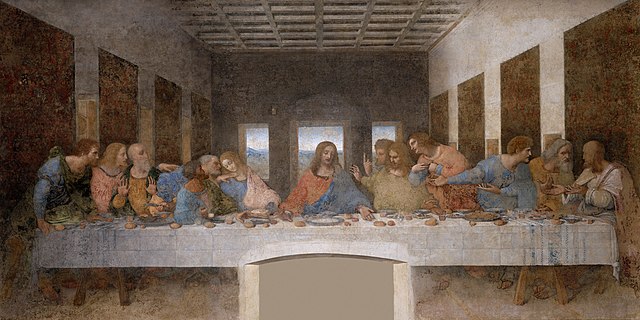“The Last Supper” is one of the most famous and historically significant artworks ever created. Painted by Leonardo da Vinci between 1495 and 1498, the mural depicts the moment Jesus Christ announces to his disciples that one of them will betray him. Its historical significance is multifaceted and includes aspects of art, religion, and cultural history:
Religious Significance:
The Last Supper captures a pivotal moment in Christian theology. According to the Gospels, Jesus shared a meal with his disciples just before his crucifixion. During this meal, he instituted the sacrament of the Eucharist, which is central to Christian beliefs. The bread and wine symbolize his body and blood, representing the ultimate sacrifice for the forgiveness of sins.
Artistic Innovation:
Leonardo da Vinci‘s approach to depicting this religious event was innovative and groundbreaking. The composition, with its use of perspective, lighting, and character expressions, set new standards for Renaissance art. The painting’s use of a one-point perspective creates a dramatic focal point on Jesus, drawing viewers into the scene.
Historical Accuracy:
Leonardo’s attention to historical accuracy is noteworthy. He meticulously researched details, including clothing, architectural elements, and the appearance of the disciples. This commitment to authenticity made “The Last Supper” an important historical record of Renaissance Italian culture.
Restoration and Preservation:
Over the centuries, the painting has faced significant challenges in terms of preservation. It has been damaged by humidity, war, and earlier restoration efforts. Its historical significance extends to ongoing efforts to restore and preserve it. Various restoration attempts have contributed to our understanding of Renaissance painting techniques.
Cultural Impact:
“The Last Supper” has been a symbol of cultural and artistic achievement. Its influence can be seen in countless depictions of the Last Supper in Western art, as well as in popular culture. The painting’s impact on the world of art, religion, and culture is immeasurable.
Historical Context:
“The Last Supper” was created during a period of great historical significance. The late 15th century was marked by the Renaissance, a time of profound cultural and intellectual awakening in Europe. The painting reflects the spirit of inquiry and discovery that characterized this era.
Depiction of Character Emotions:
Leonardo’s ability to capture the emotional and psychological state of the disciples in the painting is a remarkable historical achievement. Each disciple’s reaction to Jesus’s revelation is depicted with subtlety and realism, making the scene relatable and emotionally charged.
Impact on Art History:
“The Last Supper” contributed to the evolution of art history by influencing subsequent generations of artists. Leonardo’s mastery of perspective, composition, and storytelling techniques left a lasting mark on the development of Western art.
Tourism and Conservation:
The historical significance of “The Last Supper” has made it a major tourist attraction. This, in turn, has led to efforts to preserve and protect the artwork. The painting is now housed in a controlled environment at the Convent of Santa Maria delle Grazie in Milan, Italy.
Restoration Challenges:
The process of restoring and conserving “The Last Supper” has itself become a part of its history. Numerous restoration attempts have been made, and each has contributed to our understanding of the painting and the challenges of preserving artworks of this historical importance.
In summary, “The Last Supper” by Leonardo da Vinci holds immense historical significance due to its portrayal of a key moment in Christian theology, its artistic innovation, its role in preserving historical accuracy, and its broader impact on art, culture, and history. It stands as a testament to both religious devotion and artistic brilliance.









